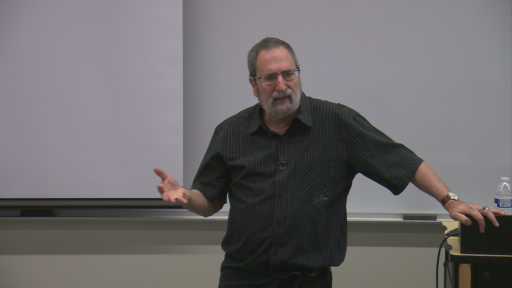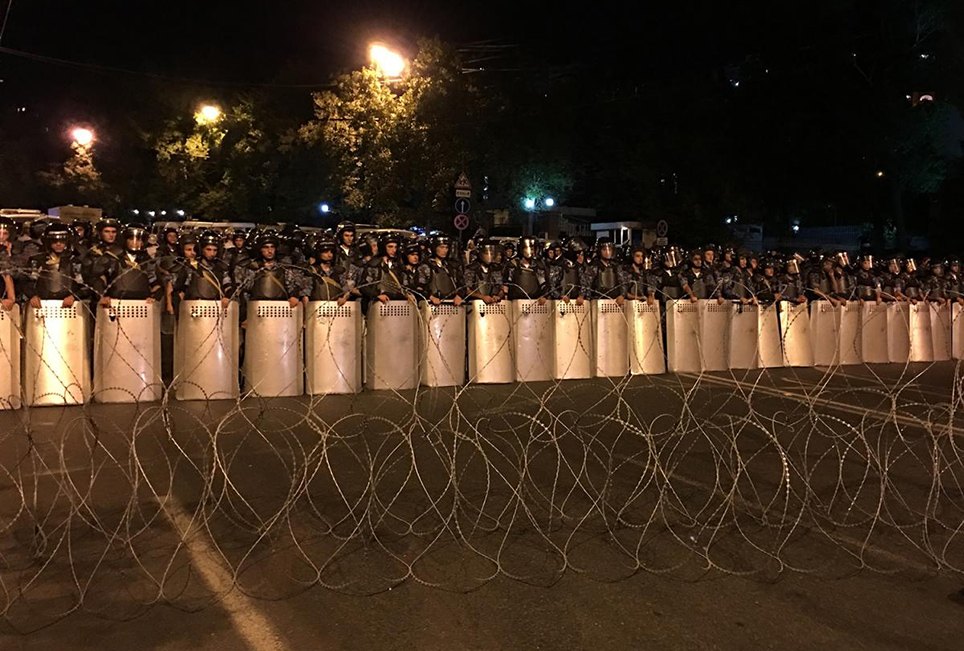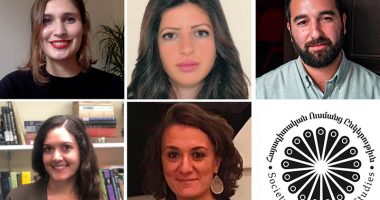In the 20th century the Armenian and Jewish peoples experienced what they both considered to be “calamities” or “catastrophes”, for which Raphael Lempkin, a Polish-Jewish lawyer, coined the term “genocide”. Parallels and connections between the two genocides have been discussed and analysed within academic circles. However, the two genocides have been an important topic not only within academia but also in the domain of film. The Programme of Armenian Studies, in cooperation with the UCL Department of Hebrew and Jewish Studies, was delighted to host Professor Lawrence Baron to give a lecture on the topic of the Armenian-Jewish connection found in genocide films. The lecture took place in London. Chair of the event was Professor Michael Berkowitz from the UCL Department of Hebrew and Jewish Studies.
Professor Lawrence Baron has held the Nasatir Chair of Modern Jewish History at San Diego State University since 1988 and directed its Jewish Studies Program until 2006. He received his Ph.D. in modern European cultural and intellectual history from the University of Wisconsin where he studied with George L. Mosse. He taught at St. Lawrence University from 1975 until 1988. He has authored and edited four books including “The Modern Jewish Experience in World Cinema” (Brandeis University Press: 2011) and “Projecting the Holocaust into the Present: The Changing Focus of Contemporary Holocaust Cinema” (Rowman and Littlefield: 2005). He served as the historian and as an interviewer for Sam and Pearl Oliner’s “The Altruistic Personality: Rescuers of Jews in Nazi Europe”. In 2006 he delivered the keynote address for Yad Vashem’s first conference devoted to Hollywood and the Holocaust. His contribution to Holocaust Studies was profiled in “Fifty Key Thinkers on the Holocaust and Genocide” (Routledge: 2010). In the autumn of 2015, he was the Ida King Distinguished Visiting Scholar in Holocaust Studies at the Richard Stockton University of New Jersey.
The connection between the two genocides has often been associated with Hitler’s infamous words – “who, after all, speaks today of the annihilation of the Armenians?” These words are said to have provided Hitler with the psychological security of deciding to commit the same atrocities to the Jews in World War Two that the Ottoman state committed to the Armenians in World War One. The parallels between the Armenian and Jewish experiences have been expressed through a number of art forms, but perhaps the most striking parallels are manifested in films. Due to the efforts of the successive Turkish governments to deny the historicity of the Armenian genocide and to repress the expression of those memories, it meant that Jewish Holocaust films were the first to set the ground for films that tackled the subject of genocide.
The first film that Lawrence mentions is “Ravished Armenia”, which was made in America in 1919. It is based on the book written by Arshaluys (Aurora) Mardiganian, in which she describes what she witnessed and experienced during the Armenian genocide. It was said that the purpose of making this film was to acquaint Americans with the horrors of the genocide and it was specifically through film that this message was to be propagated, as it would reach millions, while the printed word would only reach thousands. As an intellectual and cultural historian, Lawrence noted that he studies the spread of ideas in cultures, and it is primarily for this reason that his main interest lies in film, since it reaches the largest audience. The sheer popularity of film in the modern age makes it a huge source of ideas to which large audiences refer.
The first mention of the Armenian-Jewish connection was not actually a film but a book – the Forty Days of Musa Dagh – written by the Austrian-Jewish writer, Franz Werfel, who was inspired to write the novel after coming across droves of starving Armenian orphans and refugees in the Middle East. The novel was published in 1933, coinciding with the rise of Hitler, whom Werfel condemned by using the Armenian Genocide to draw attention to the imminent danger that awaited the Jews. The novel allowed Jews living in the Third Reich to compare their situation with those Armenians resisting the violence of Turkish fascism. Parallels were thus drawn between the Warsaw ghetto uprising of Jews and the resistance of Armenians at Musa Dagh. Lawrence associates this process of using the image of one genocide for another with “multi-directional memory”, which signifies the evoking of familiar images from one event to another
Turkey used its political leverage as a bulwark against the spread of Communism from the Soviet Union, and now uses its status as a NATO member, to prevent the official acknowledgement of the Armenian Genocide around the world and to suppress popular representation of the event. This meant that the Jewish experience of genocide was the first to be given free rein to represent its memories in film. Consequently, instead of associating genocide with the images of Armenians marching to the Syrian dessert, images of modern concentration camps are conjured in the Western consciousness. In order for the Armenian Genocide to be better comprehended by Western audiences, it has been said that “the deployment of Holocaust imagery renders the Armenian atrocities culturally legible as a genocide”. An example that Lawrence gave is the use of Samuel Barber’s Adagio for Strings in “Ravished Armenia” as an exercise in multi-directional memory and this score was then often used to portray mourning. The image of one event is thus extrapolated subconsciously by audiences and is related to another event when that image is again deployed.
Unfortunately, there is a long history of intimidation by the Turkish state suppressing the ability of filmmakers to portray the Armenian genocide through film effectively in the West. This was also an issue in the Soviet Union since it was not keen on allowing Armenians to evoke memories that would bolster national consciousness. This was similar to the restrictions on Yiddish literature by the Communist Party. Nevertheless, there was a slight opening in film-making after demonstrations on the 50th anniversary of the genocide in 1965. Although most of these films alluded to the Armenian genocide visually and verbally as a “coded sub-text”, there were two Soviet Armenian filmmakers who tackled the subject as a psychological wound that torments the Armenians who lived in Soviet Armenia. One of them was Henrik Malayan who directed the film “Nahapet” in 1977. This film was, however, still subject to censorship and could not fully express the psychological dynamics of being a survivor of the Armenian genocide. “Nahapet” became the inspiration for another film called “Karot” (The Yearning), directed by Frunze Dovlatyan, which was made in 1990. The film is set in the 1930s when Stalin cracked down on any form of ethnic nationalism. It tells the story of a peasant who is tormented by memories of Turkish soldiers raiding his village. He decides to cross the Soviet-Turkish border to visit the ruins of his former home where he imagines the flames that had swept the village and he meets a girl that had been brought up in a Kurdish family. The imagery of these flames is reminiscent of one of the first Jewish Holocaust films, “Ladies’ Tailor”, which uses the exact same imagery. The orphaned girl in “Karot” can scream but she makes no noise. This is to say that she can attempt to express her pain, but nobody will listen or understand. The Armenian scholar Rubina Peroomian draws parallels between Armenian and Jewish genocide literature by noting this feature of being unable to explain these painful memories to others or to get others to believe those memories.
The political climate over the past two decades has given more freedom to those who wish to make films about the Armenian genocide in Armenia and the West. An Italian film, called “The Lark Farm”, was made in 2007 and it depicts a well-to-do Armenian family who detect the growing anti-Armenian sentiment and attempt to escape the killings by utilizing their affluence and influence to deflect aggression from the state. There are indubitable parallels between this film and another Italian film from 1970, called “The Garden of the Finzi-Continis”, in which a wealthy Jewish family believe that their influence will prevent them from being affected by the rising tide of Fascism and anti-Semitism in the 1930s. The film that best weaves the stories of both the Armenians and the Jews is the French film “The Army of Crime”, in which the Armenian Missak Manouchian recruits a brigade of leftist immigrants, nearly half of whom were Jewish, to assassinate German soldiers and sabotage war industries in Paris in 1943. In this film, the producer, Robert Guédiguian, ties the fates of the Armenians and Jews together.
Atom Egoyan, the Canadian-Armenian filmmaker, produced the film “Ararat”, which was much anticipated by Armenians, in 2002. The film depicts how various characters, such as a historian, a son of a terrorist, an artist (Arshile Gorky), deal with their memories of the Armenian genocide. Lawrence showed a clip from the film which he describes as the most effective use of the “Hitler quote”. In the clip, Raffi, the son of the Armenian terrorist, is discussing the Armenian genocide with the actor who is going to play the character of Cevdet Bey in the film within the film. The actor attempts to convince Raffi that the painful history should be forgotten and that their new lives in America should be a fresh start. Raffi says to the actor, “Do you know what else Hitler told his military commanders to convince them that his plan would work? Who remembers the extermination of the Armenians?” The actor replies saying, “And nobody did…nobody does…”
There have been recent developments in terms of Armenian-Turkish relations within the domain of film. The Golden Apricot Festival in Yerevan has started to act as a platform for Armenian and Turkish filmmakers to meet and discuss issues together. “The Cut” is the first Armenian genocide film to be produced by somebody of Turkish descent, Fatih Akin. The dissemination of such films does matter since they are being watched by masses of people. The NBC series “Holocaust” had a significant effect on the popularization of the Holocaust and education about it. The same goes for films such as “Schindler’s List” and “Hotel Rwanda”. Hopefully one day Armenians will not need to refer to the Holocaust because audience around the world will remember the Armenians.










